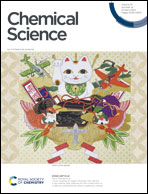Reversible dioxygen uptake at [Cu4] clusters†
Abstract
Dioxygen binding solely through non-covalent interactions is rare. In living systems, dioxygen transport takes place via iron or copper-containing biological cofactors. Specifically, a reversible covalent interaction is established when O2 binds to the mono or polynuclear metal center. However, O2 stabilization in the absence of covalent bond formation is challenging and rarely observed. Here, we demonstrate a unique example of reversible non-covalent binding of dioxygen within the cavity of a well-defined synthetic all-Cu(I) tetracopper cluster.
![Graphical abstract: Reversible dioxygen uptake at [Cu4] clusters](/en/Image/Get?imageInfo.ImageType=GA&imageInfo.ImageIdentifier.ManuscriptID=D3SC06390A&imageInfo.ImageIdentifier.Year=2024)


 Please wait while we load your content...
Please wait while we load your content...